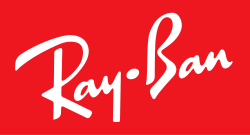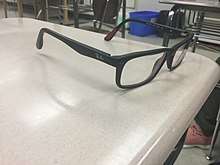Ray-Ban
 | |
| Subsidiary | |
| Founded |
1937 in Rochester, New York, United States |
Area served | Worldwide |
Key people | Leonardo Del Vecchio |
| Products | |
| Owners | Luxottica Group |
| Website | ray-ban.com |
Ray-Ban is a brand of sunglasses and eyeglasses created in 1937 by the American company Bausch & Lomb. The brand is known for their Wayfarer and Aviator lines of sunglasses. In 1999, Bausch & Lomb sold the brand to the Italian eyewear conglomerate, Luxottica Group, for a reported US$640 million.[1]

History
In 1929, US Army Air Corps Colonel John A. Macready worked with Bausch & Lomb, a Rochester, New York-based medical equipment manufacturer, to create aviation sunglasses that would reduce the distraction for pilots caused by the intense blue and white hues of the sky.[2][3][4] Specifically, MacCready was concerned about how pilots' goggles would fog up, greatly reducing visibility at high altitude.[5] The prototype, created in 1936 and known as ‘Anti-Glare’, had plastic frames and green lenses that could cut out the glare without obscuring vision. They also added impact-resistant lenses in 1938.[6] The sunglasses were redesigned with a metal frame the following year and patented as the Ray-Ban Aviator.[5] According to the BBC, the glasses used “Kalichrome lenses designed to sharpen details and minimise haze by filtering out blue light, making them ideal for misty conditions.”[5]
In 1999, the Global Eyewear Division of Bausch & Lomb, including Ray-Ban was acquired by Luxottica Group for US$640 million.[1]
Sunglasses lines
Ray-Ban's most popular sunglasses are the Wayfarer and Aviator models.[5][7][8] During the 1950s, Ray-Ban released the Echelon (Caravan), which had a squarer frame. In 1965, the Olympian I and II were introduced; they became popular when Peter Fonda wore them in the 1969 film Easy Rider.[9] The company has also produced special edition lines, such as The General in 1987, bearing similarity to the original aviators worn by General Douglas MacArthur during the Second World War.[6]
References
- 1 2 "Company News: Bausch & Lomb Selling Sunglass Business to Luxottica". NY Times. April 29, 1999. Retrieved September 5, 2010.
- ↑ Pagan Kennedy (3 August 2012). "Who Made Those Aviator Sunglasses?". New York Times. Archived from the original on 21 August 2012. Retrieved 1 May 2017.
And so Macready began working with Bausch & Lomb to design goggles especially suited to protect against the dazzle in the stratosphere. “My dad gave Bausch & Lomb the original shape, tint and fit” of aviator lenses, Wallace said.
- ↑ "The best ever ray-bans".
- ↑ "You can thank the US military for the world's most famous sunglasses". Business Insider France (in French). Retrieved 2017-05-24.
- 1 2 3 4 Foreman, Katya. "The enduring appeal of aviator sunglasses".
- 1 2 "Fashion Notes". 24 May 1987.
- ↑ Williamson, Charlote; Davis (1 September 2007). "101 Things to Buy Before You Die". New Holland Publishers – via Google Books.
- ↑ Shilling, Donovan A. (1 January 2011). "A Photographic History of Bausch + Lomb". Pancoast Publishing – via Google Books.
- ↑ "Mad Men Don Draper Meets Peter Fonda in Easy Rider (1969)". 14 November 2014.